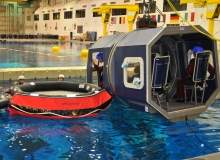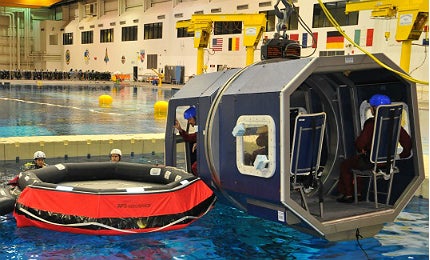
For more than a year, Nasa has been working with Petrofac to deliver a suite of safety courses to current and future offshore oil workers.
Delegates are taught how to survive helicopter ditching and put out fires in simulated scenarios at the Neutral Buoyancy Laboratory (NBL) in Houston, which is also used for spacewalk planning and training.
In February, the Hi-Con Training Programme was reapproved to provide safety courses to the Offshore Petroleum Industry Training Organisation (OPITO) standard, demonstrating the need for high-quality training in the sector.
Here, Cindy Hendershot, programmes manager at Raytheon Technical Services, Nasa’s contractor for operations at NBL, explains why the space and offshore industries make the perfect match when it comes to work safety training and Raytheon’s plans to expand its course offering to those working on board floating production vessels.
Sarah Blackman: How successful has the Hi-Con Training Programme been since its launch in November 2011?
Cindy Hendershot: We have had, as of today, more than 600 delegates go through and we’ve had fantastic feedback on the facility and the instructors. What we’ve done is taken the same people who support astronaut diving in the NDL [no decompression limit] and Petrofac has trained them to be instructors for this training programme.
SB: What training courses do you offer?
CH: We have the three-day Basic Offshore Safety Induction and Emergency Training (BOSIET) which is required in many areas of the world, especially in the North Sea.
What it does is it teaches you skills for surviving a helicopter ditching – how you get into a life raft and how you protect yourself.
We also teach basic fire-fighting skills for if you are on a rig and you don’t have fire-fighting help at the time. We teach you how to put the fire out and, essentially, self-rescue techniques. Then there is the first aid portion.
We also offer a one-day refresher course called the FOET (Further Offshore Emergency Training) because the certification for the BOSIET is four years, so after that time you need a renewal. Then there is the one-day Helicopter Underwater Egress Training (HUET) course and that’s provided to people who don’t require the BOSIET, because they are going to work in warm water.
We also offer half-day fire-fighting and half-day first aid courses. Some companies who work in the Gulf of Mexico also offer our Safe Gulf course, which is classroom-based.
SB: Are there plans in the pipeline to expand your course offering?
CH: We are currently looking at offering marine training for people who are going to work on or operate a vessel, such as a floating production vessel, or any kind of vessel that participates in drilling or well development. This training has to be coast-guard approved so there is a little bit more that’s required of people on a vessel. We are looking at partnering with the Texas Marine Academy at Texas A&M University in Galveston to offer a complete vessel training course.
SB: How do your instructors simulate dangerous situations in the oil and gas industry?
CH: In the helicopter training portion, they tell you what will happen to you if a helicopter has to ditch. Then they have you go though six or seven scenarios, starting from getting into the helicopter in a dry environment on the deck of the pool, and working up to the more complex scenario of going under water in a submerged helicopter that is then capsized.
There’s another a complex scenario where you are not only capsized and underwater but you have to escape out of a window on the opposite side of the cabin, instead of the one right next to you.
I’ve taken the HUET part of the course and it’s the scariest course for all delegates, but the way that Petrofac works you up is comforting and it helps you build your confidence.
In the fire training portion, the instructors tell you how and where fires could start and how to put them out. Then they demonstrate how you use each kind of fire extinguisher. We are not teaching them to be professional fire fighters by any means, but we are teaching them a first level of basic fire fighting and self rescue.
SB: What was the reason behind Nasa’s decision to train the oil and gas workforce?
CH: We at the Neutral Buoyancy Laboratory have a very strong safety culture and we chose to partner with Petrofac because of their strong safety culture.
Workers at Nasa and in the offshore industry do similar work in terms of diving, rigging and lifting, so we felt that the two cultures would mesh well.
Raytheon is on contract to provide not only the operations of the Neutral Buoyancy Laboratory but to help Nasa bring in other users as Nasa-use has dropped off in the last year or so. So we felt like this was an excellent fit from a technical capability standpoint of our people.
SB: Do you think that work safety is lacking in the oil and gas industry?
CH: Well, I think that offshore is a very high risk environment and, to me, it’s very similar to operating in space. We train people to operate in those high consequence environments. So I don’t know if [the industry is] not safe, but safety training is very important in an environment like that.
SB: How has the safety programme altered since it was approved to deliver survival courses to the OPITO standard in April 2012?
CH: What we had to do to get that approval was to essentially implement all the capabilities that you need to provide OPITO training. Just last week we had OPITO in for a surveillance audit and they reapproved us.
There’s always room for improvement in this area so they gave us a few pointers, mainly in the management of the infrastructure, but they thought the instructors were doing a great job and, for the most part, they thought that what we are doing is well within the standard.
Related content
Offshore security training: shaking up the status quo
In an unpredictable offshore environment, are the current methods of training offshore security personnel in need of a shake-up?
Video feature: Shell’s hollow victory in the Niger Delta
Oil giant Shell recently won four out of five cases brought against it in court by Nigerian farmers seeking reparations for lost income due to pollution in the Niger Delta.
Follow Sarah Blackman on Google+



.gif)

